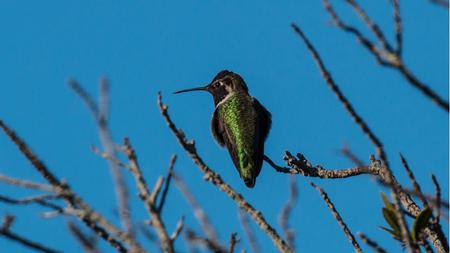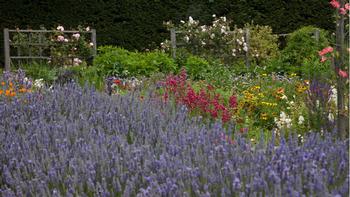Habitat gardens entice tiny winged friends into the garden
-
It’s remarkably easy to attract songbirds, bees, butterflies, hummingbirds and welcomed insects into your garden. All you have to do is grow the plants they need to nest and eat, and provide a sip of water. This is called habitat gardening, and it’s more important now than ever.
 Hummingbirds are important pollinators – and a delight to watch in the garden. Photo: Karen Gideon
Hummingbirds are important pollinators – and a delight to watch in the garden. Photo: Karen GideonThe National Audubon Society reports that more than half the bird species in North America face a severe threat to survival. This includes the Rufous hummingbird, a tiny zooming cinnamon-colored beauty whose population has dipped 60%. The monarch butterfly population is also on the decline, along with bees. We know the many reasons for these cautionary reports: climate change, habitat loss, development, herbicides, and pesticides.
Will making minor changes in your garden really make a difference? The answer is unequivocally yes. Empirical evidence shows that enticing these profoundly valuable pollinators benefits our gardens as well as the animal and human food supplies that we cherish.
To create a habitat garden that is wildlife-friendly, you need to include: Habitat gardens provide food, water, and cover for bees, butterflies, and other beneficial insects. Photo: Marybeth Kampman
Habitat gardens provide food, water, and cover for bees, butterflies, and other beneficial insects. Photo: Marybeth Kampman- Food sources: Plants provide basic food for wildlife in the form of seeds, berries, nuts, fruits, nectar, sap, pollen, and foliage and twigs. Of course, in the garden ecosystem, some animals may become food for other animals, for example caterpillars or insects provide nourishment for birds.
- Water sources: Wildlife must have water to drink and in which to bathe. A water source in the garden may be a spring, a stream or a lake. For most of us without those natural resources, an artificial pond, a pump-driven fountain, a cement birdbath or even a depression in a stone can serve as a life-giving water source.
- Cover and protection: Wildlife need protection from predators and shelter and cover from the weather. Dense shrubs, brambles, evergreens, rock piles or walls, and wooded areas provide protection and shelter. A little messiness, in the form of piles of branches or untrimmed shrubs, around the edges of a garden can provide a refuge for birds and mammals.
- Places for young wildlife: To succeed as a habitat, a garden must provide a place for wildlife to bear and raise their young. Ideal locations are places predators have a hard time invading. These include mature trees, dead trees or snags, thickets or dense shrubs, wetlands and burrows. If your garden does not include any of these, home-made nesting boxes are an alternative. To create a habitat for butterflies, learn which plants are hosts for the larvae (caterpillars) of a given species and plant them in your garden. For example, milkweed is a host plant for larvae of the monarch butterfly; California Dutchman's pipe is a host plant for larvae of the pipevine swallowtail butterfly.
- Sustainable gardening practices: The way we manage the water, weeds and soil in our gardens affects the general habitat for wildlife living there. Water should be managed to minimize waste. Xeriscape or water-wise landscaping will reduce the cost of irrigation, as will drip systems and soaker hoses. To reduce erosion of wildlife habitat, plant ground covers - preferably native species - or build terraces. Chemicals from synthetic pesticides and fertilizers may be toxic to the insects and birds we are trying to encourage. Although pulling weeds by hand is labor-intensive, that labor can be minimized by heavy mulching, which prevents the growth of weeds in the first place. As an alternative to synthetic fertilizers, soil can be improved with organic fertilizer such as the sustainable aged manure produced by sheep or cows. Compost is a sustainable fertilizer because it is created from the waste plant material of the garden itself.
- Food sources: Plants provide basic food for wildlife in the form of seeds, berries, nuts, fruits, nectar, sap, pollen, and foliage and twigs. Of course, in the garden ecosystem, some animals may become food for other animals, for example caterpillars or insects provide nourishment for birds.


